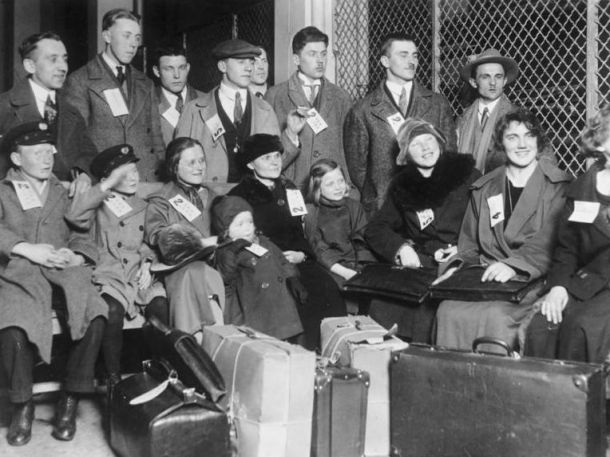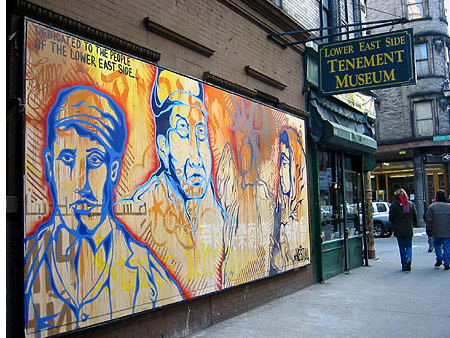
The impact of immigrants on New York City’s culture is evident throughout the city: from the Lunar New Year festivals to the Haitian churches sprinkled throughout the boroughs, the hip Spanish restaurants serving traditional tapas to the ubiquity of Italian food, immigrants’ footprints are everywhere. This is no surprise when you consider the city’s rich history as a gateway to America.Immigrant Heritage Week, established by Mayor Michael Bloomberg in 2004, is a reminder of the contributions of the city’s immigrants from this and past generations. Now celebrating its 10th year, Immigrant Heritage Week kicks off April 17 and includes a number of events at museums and theaters throughout the city. One highlight of the week is the American Dreamer Awards which honor individuals and organizations whose significant accomplishments and contributions have improved the lives of immigrants and their communities in New York City.Other events taking place include:
Jewish Immigrant Heritage Trail at the Eldridge Street SynagogueApril 18 – 2-3:00 p.m.12 Eldridge Street, ManhattanHome to hundreds of thousands of Jewish immigrants a century ago, the Lower East Side was once the heart and soul of the American Jewish community. Come explore the old neighborhood and take a step back in time. Stops include The Eldridge Street Synagogue, The Jewish Daily Forward Building, the old Loews Theater, and of course time out for pickles and candy.
Reel Lives Documentary ScreeningApril 18 – 6:00 p.m.2 Lincoln Square, ManhattanIn collaboration with Reel Lives, the American Folk Art Museum is hosting a special screening of three original documentaries followed by a discussion with the filmmakers. Each of the three short films explores the experiences of immigration and identity formation as a teenager in America. These autobiographical portraits draw from the diverse cultural landscapes of the Dominican Republic, the Lubavitch community of Brooklyn, and Tibet, examining how one navigates a new life during adolescence.
Tablao Flamenco by the American Bolero Dance CompanyApril 19 – 8:30 p.m.44-01 Broadway, Astoria, QueensAmerican Bolero Dance Company celebrates Immigrant Heritage Week with the April 19 installment of its 2013 Tablao Flamenco series, which showcases a variety of Spanish dance and music in a cabaret-like format and atmosphere.
A Day in the Life Scavenger HuntApril 20 and 21 – 11:00 a.m. – 4:00 p.m.421 East 61st Street, ManhattanCelebrate Immigrant Heritage Week by learning about the lives of the workers in 1830, many of them immigrants, who ensured that the Mount Vernon Hotel operated smoothly.
Step Back in Time
New York City’s rich immigrant history owes itself in part to the opening of Ellis Island as an immigration processing center. Ellis Island for decades was the first stop of immigrants entering the United States to start a new life in what was – and still is – a land of opportunity. It opened as the country’s first Federal immigration station on January 1, 1892. Over the 54 years that Ellis Island was open as an immigration facility, more than 12 million immigrants entered the United States through the processing center, facing an extensive inspection process. Famous names such as Albert Einstein, Giacomo Puccini, George Gershwin, F. Scott Fitzgerald, and Rudyard Kipling passed through Ellis Island. Today, more than 100 million Americans – nearly a third of the entire population – can trace their heritage back to the landmark immigration center.Ellis Island Immigration Museum is a fascinating visit for anyone interested in history or the importance of immigrants to the city’s – and country’s – development. After being closed in 1954, Ellis Island fell largely into despair, protected only as part of the Statue of Liberty National Monument. The building went under an extensive renovation in 1990 and operates today as the country’s largest immigration museum. Visitors to the Ellis Island Immigration Museum can get an in-depth look at the grueling, and often unfair, inspection process; listen to voice recordings of people who were processed through the island, recounting their personal experiences; and view some of the actual baggage and clothing worn by immigrants arriving at Ellis Island. The immigration museum is often visited in conjunction with the Statue of Liberty, which is reached by the same ferry. Unfortunately, due to damage incurred from Hurricane Sandy in 2012, the museum is not expected to open in 2013, but renovations are in progress.Another notable museum on immigration is Manhattan’s Tenement Museum. Located on the Lower East Side at 97 Orchard Street, the building was home to more than 7,000 working class immigrants from 1863 to 1935. The museum offers tours and educational programs looking back in time to what life was like for some of New York City’s first citizens. The Tenement Museum also offers tours of the Lower East Side, offering a look at what the immigrant population did to shape this popular Manhattan neighborhood.
The immigration museum is often visited in conjunction with the Statue of Liberty, which is reached by the same ferry. Unfortunately, due to damage incurred from Hurricane Sandy in 2012, the museum is not expected to open in 2013, but renovations are in progress.Another notable museum on immigration is Manhattan’s Tenement Museum. Located on the Lower East Side at 97 Orchard Street, the building was home to more than 7,000 working class immigrants from 1863 to 1935. The museum offers tours and educational programs looking back in time to what life was like for some of New York City’s first citizens. The Tenement Museum also offers tours of the Lower East Side, offering a look at what the immigrant population did to shape this popular Manhattan neighborhood.
The Continuing Importance of Immigrants in NYC
Today’s immigrant population continues to play a vital role in New York City’s economy, creating jobs and bringing some of the most innovative technology to the city’s many economic sectors. Immigrant entrepreneurs are prominent in the city’s business sectors, accounting for roughly 40% of New York City’s computer design, architectural, engineering, and real estate firms.There continues to be a need for immigrants in the city as the burgeoning tech sector, engineering fields, and other positions requiring advanced degrees remain unfilled by America’s workforce. This combined with the other advantages of a diverse international population – international restaurants, art, theater and more – are critical to New York remaining a world-class city.

